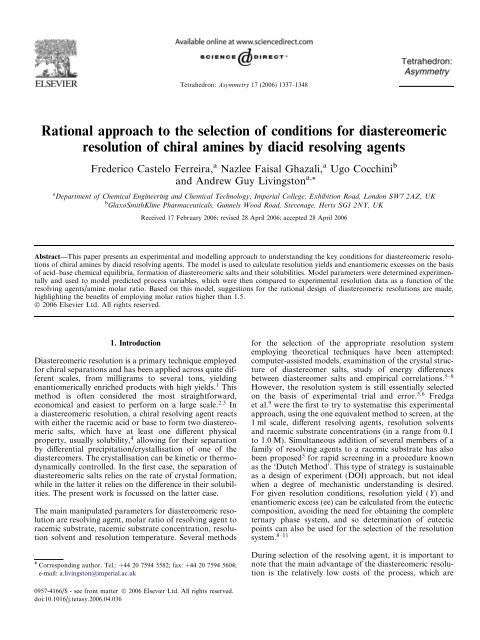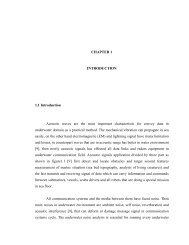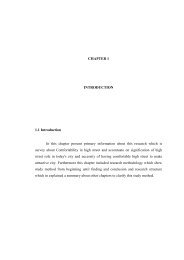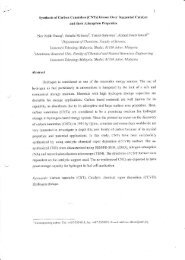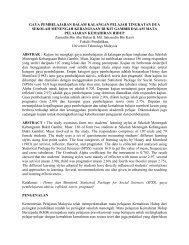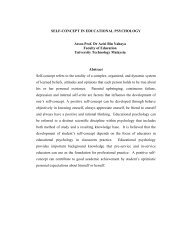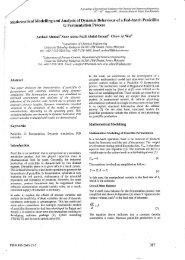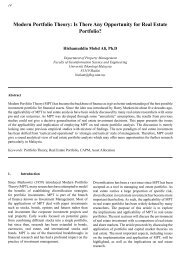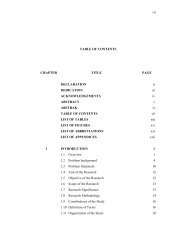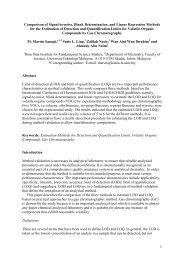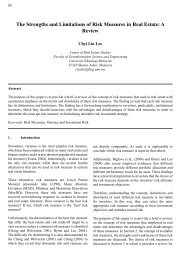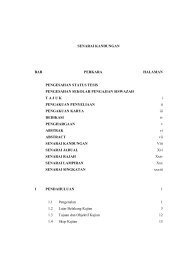Rational approach to the selection of conditions for diastereomeric ...
Rational approach to the selection of conditions for diastereomeric ...
Rational approach to the selection of conditions for diastereomeric ...
You also want an ePaper? Increase the reach of your titles
YUMPU automatically turns print PDFs into web optimized ePapers that Google loves.
Tetrahedron: Asymmetry 17 (2006) 1337–1348<br />
<strong>Rational</strong> <strong>approach</strong> <strong>to</strong> <strong>the</strong> <strong>selection</strong> <strong>of</strong> <strong>conditions</strong> <strong>for</strong> <strong>diastereomeric</strong><br />
resolution <strong>of</strong> chiral amines by diacid resolving agents<br />
Frederico Castelo Ferreira, a Nazlee Faisal Ghazali, a Ugo Cocchini b<br />
and Andrew Guy Livings<strong>to</strong>n a, *<br />
a Department <strong>of</strong> Chemical Engineering and Chemical Technology, Imperial College, Exhibition Road, London SW7 2AZ, UK<br />
b GlaxoSmithKline Pharmaceuticals, Gunnels Wood Road, Stevenage, Herts SG1 2NY, UK<br />
Received 17 February 2006; revised 28 April 2006; accepted 28 April 2006<br />
Abstract—This paper presents an experimental and modelling <strong>approach</strong> <strong>to</strong> understanding <strong>the</strong> key <strong>conditions</strong> <strong>for</strong> <strong>diastereomeric</strong> resolutions<br />
<strong>of</strong> chiral amines by diacid resolving agents. The model is used <strong>to</strong> calculate resolution yields and enantiomeric excesses on <strong>the</strong> basis<br />
<strong>of</strong> acid–base chemical equilibria, <strong>for</strong>mation <strong>of</strong> <strong>diastereomeric</strong> salts and <strong>the</strong>ir solubilities. Model parameters were determined experimentally<br />
and used <strong>to</strong> model predicted process variables, which were <strong>the</strong>n compared <strong>to</strong> experimental resolution data as a function <strong>of</strong> <strong>the</strong><br />
resolving agents/amine molar ratio. Based on this model, suggestions <strong>for</strong> <strong>the</strong> rational design <strong>of</strong> <strong>diastereomeric</strong> resolutions are made,<br />
highlighting <strong>the</strong> benefits <strong>of</strong> employing molar ratios higher than 1.5.<br />
Ó 2006 Elsevier Ltd. All rights reserved.<br />
1. Introduction<br />
Diastereomeric resolution is a primary technique employed<br />
<strong>for</strong> chiral separations and has been applied across quite different<br />
scales, from milligrams <strong>to</strong> several <strong>to</strong>ns, yielding<br />
enantiomerically enriched products with high yields. 1 This<br />
method is <strong>of</strong>ten considered <strong>the</strong> most straight<strong>for</strong>ward,<br />
economical and easiest <strong>to</strong> per<strong>for</strong>m on a large scale. 2,3 In<br />
a <strong>diastereomeric</strong> resolution, a chiral resolving agent reacts<br />
with ei<strong>the</strong>r <strong>the</strong> racemic acid or base <strong>to</strong> <strong>for</strong>m two <strong>diastereomeric</strong><br />
salts, which have at least one different physical<br />
property, usually solubility, 4 allowing <strong>for</strong> <strong>the</strong>ir separation<br />
by differential precipitation/crystallisation <strong>of</strong> one <strong>of</strong> <strong>the</strong><br />
diastereomers. The crystallisation can be kinetic or <strong>the</strong>rmodynamically<br />
controlled. In <strong>the</strong> first case, <strong>the</strong> separation <strong>of</strong><br />
<strong>diastereomeric</strong> salts relies on <strong>the</strong> rate <strong>of</strong> crystal <strong>for</strong>mation,<br />
while in <strong>the</strong> latter it relies on <strong>the</strong> difference in <strong>the</strong>ir solubilities.<br />
The present work is focussed on <strong>the</strong> latter case.<br />
The main manipulated parameters <strong>for</strong> <strong>diastereomeric</strong> resolution<br />
are resolving agent, molar ratio <strong>of</strong> resolving agent <strong>to</strong><br />
racemic substrate, racemic substrate concentration, resolution<br />
solvent and resolution temperature. Several methods<br />
* Corresponding author. Tel.: +44 20 7594 5582; fax: +44 20 7594 5604;<br />
e-mail: a.livings<strong>to</strong>n@imperial.ac.uk<br />
<strong>for</strong> <strong>the</strong> <strong>selection</strong> <strong>of</strong> <strong>the</strong> appropriate resolution system<br />
employing <strong>the</strong>oretical techniques have been attempted:<br />
computer-assisted models, examination <strong>of</strong> <strong>the</strong> crystal structure<br />
<strong>of</strong> diastereomer salts, study <strong>of</strong> energy differences<br />
between diastereomer salts and empirical correlations. 5–8<br />
However, <strong>the</strong> resolution system is still essentially selected<br />
on <strong>the</strong> basis <strong>of</strong> experimental trial and error. 5,6 Fredga<br />
et al. 9 were <strong>the</strong> first <strong>to</strong> try <strong>to</strong> systematise this experimental<br />
<strong>approach</strong>, using <strong>the</strong> one equivalent method <strong>to</strong> screen, at <strong>the</strong><br />
1 ml scale, different resolving agents, resolution solvents<br />
and racemic substrate concentrations (in a range from 0.1<br />
<strong>to</strong> 1.0 M). Simultaneous addition <strong>of</strong> several members <strong>of</strong> a<br />
family <strong>of</strong> resolving agents <strong>to</strong> a racemic substrate has also<br />
been proposed 5 <strong>for</strong> rapid screening in a procedure known<br />
as <strong>the</strong> ‘Dutch Method’. This type <strong>of</strong> strategy is sustainable<br />
as a design <strong>of</strong> experiment (DOI) <strong>approach</strong>, but not ideal<br />
when a degree <strong>of</strong> mechanistic understanding is desired.<br />
For given resolution <strong>conditions</strong>, resolution yield (Y) and<br />
enantiomeric excess (ee) can be calculated from <strong>the</strong> eutectic<br />
composition, avoiding <strong>the</strong> need <strong>for</strong> obtaining <strong>the</strong> complete<br />
ternary phase system, and so determination <strong>of</strong> eutectic<br />
points can also be used <strong>for</strong> <strong>the</strong> <strong>selection</strong> <strong>of</strong> <strong>the</strong> resolution<br />
system. 8–11<br />
During <strong>selection</strong> <strong>of</strong> <strong>the</strong> resolving agent, it is important <strong>to</strong><br />
note that <strong>the</strong> main advantage <strong>of</strong> <strong>the</strong> <strong>diastereomeric</strong> resolution<br />
is <strong>the</strong> relatively low costs <strong>of</strong> <strong>the</strong> process, which are<br />
0957-4166/$ - see front matter Ó 2006 Elsevier Ltd. All rights reserved.<br />
doi:10.1016/j.tetasy.2006.04.036
1338 F. C. Ferreira et al. / Tetrahedron: Asymmetry 17 (2006) 1337–1348<br />
mainly associated with <strong>the</strong> resolving agent costs. Looking<br />
at <strong>the</strong> commonly available resolving agents, tartaric acid<br />
and its derivatives are <strong>the</strong> most popular choice <strong>for</strong> resolving<br />
chiral bases, accounting, <strong>for</strong> 1368 resolutions <strong>of</strong> chiral<br />
bases reported by Kozma. 12 Some 33% <strong>of</strong> <strong>the</strong>se were per<strong>for</strong>med<br />
by tartaric acid and 25% by two <strong>of</strong> its derivatives,<br />
di-O,O 0 -<strong>to</strong>luyl-tartaric acid (DTTA) and di-O,O 0 -p-benzyltartaric<br />
acid (DBTA). These values reflect <strong>the</strong> consequences<br />
<strong>of</strong> tartaric acid being easily isolated from nature at a relatively<br />
low cost.<br />
It is interesting <strong>to</strong> note that <strong>the</strong>se popular resolution agents<br />
are diacids, and so can <strong>for</strong>m neutral and acidic <strong>diastereomeric</strong><br />
salts, comprising <strong>of</strong> two or one molecule <strong>of</strong> amine<br />
<strong>for</strong> each molecule <strong>of</strong> <strong>the</strong> diacid, respectively. Also, in principle,<br />
<strong>the</strong> same molecule <strong>of</strong> neutral salt can combine both<br />
amine enantiomers in <strong>the</strong> same salt, herein after referred<br />
as mixed enantiomer neutral salt. Obviously, <strong>the</strong> <strong>for</strong>mation<br />
<strong>of</strong> this salt would decrease ee. Never<strong>the</strong>less, statistically,<br />
<strong>the</strong>se diacids have found more use than monoacids; even<br />
<strong>the</strong> popular mandelic acid is only used in 8% <strong>of</strong> <strong>the</strong><br />
reported resolutions. 12<br />
Most <strong>of</strong> <strong>the</strong> resolutions described in <strong>the</strong> literature are per<strong>for</strong>med<br />
at a ratio between acid resolving agent and amine<br />
<strong>of</strong> one molar equivalent, half molar equivalent (Marckwald<br />
method) or at half molar equivalent in <strong>the</strong> presence <strong>of</strong> an<br />
achiral acid (Pope and Peachey method). Resolutions yielding<br />
solids with 100% ee at <strong>the</strong> first crystallisation are rare in<br />
<strong>the</strong> academic literature, and it is usual <strong>to</strong> find reports<br />
involving four <strong>to</strong> five consecutive re-crystallisations. 13<br />
The effect on resolutions <strong>of</strong> resolving agent diacid/amine<br />
molar ratios (C) values lower than one, 13,14 has already<br />
been studied; however, no studies have systematically<br />
reported <strong>the</strong> effect <strong>of</strong> excess resolving agent, which <strong>for</strong> dicarboxylic<br />
resolving agents favours <strong>the</strong> <strong>for</strong>mation <strong>of</strong> acidic<br />
<strong>diastereomeric</strong> salts. In parallel, a ma<strong>the</strong>matical model<br />
describing <strong>the</strong> effect <strong>of</strong> pH and C, when monoacids were<br />
used as resolving agents, was previously proposed. 15 Never<strong>the</strong>less,<br />
no ma<strong>the</strong>matical model has yet been presented<br />
describing resolutions <strong>of</strong> racemic amines by a diacid resolving<br />
agents.<br />
Herein we report a model <strong>to</strong> calculate ee, Y, and mo<strong>the</strong>r<br />
liquor pH <strong>for</strong> resolutions <strong>of</strong> chiral amines by a diacid <strong>for</strong><br />
0.2 < C < 2.0. Experiments are used <strong>to</strong> determine model<br />
parameters, and <strong>the</strong>n <strong>the</strong> models are used <strong>to</strong> predict <strong>the</strong><br />
ee and Y values. These are compared <strong>to</strong> experimental data<br />
<strong>for</strong> ee and Y obtained <strong>for</strong> two chiral amines over a range <strong>of</strong><br />
molar ratio C. Two models are considered, which neglect<br />
and include, respectively, <strong>the</strong> acid–base equilibria. A strategy<br />
<strong>for</strong> <strong>the</strong> design <strong>of</strong> <strong>diastereomeric</strong> resolutions is <strong>the</strong>n proposed.<br />
This involves measuring <strong>the</strong> solubilities <strong>of</strong> <strong>the</strong> four<br />
pure <strong>diastereomeric</strong> salts (two acid and two neutral salts)<br />
in different resolution solvent systems at given temperatures.<br />
Using <strong>the</strong>se values as model inputs, it is possible <strong>to</strong><br />
select C and amine concentration at which <strong>the</strong> resolution<br />
should be per<strong>for</strong>med. This <strong>approach</strong> is not entirely a priori,<br />
since it relies on <strong>the</strong> knowledge <strong>of</strong> <strong>the</strong> diastereomer salts<br />
solubility limits, and <strong>the</strong> main disadvantage is <strong>the</strong> need<br />
<strong>for</strong> small amounts <strong>of</strong> <strong>the</strong> pure enantiomers <strong>for</strong> preparation<br />
<strong>of</strong> <strong>the</strong> four diastereomers. However, once <strong>the</strong>se enantiomers<br />
are isolated on a preparative scale (through consecutive <strong>diastereomeric</strong><br />
resolutions, more sophisticated resolution<br />
agents or expensive resolution techniques such as chiral<br />
chroma<strong>to</strong>graphy), <strong>the</strong> proposed <strong>approach</strong> can easily be<br />
applied <strong>to</strong> design a <strong>diastereomeric</strong> resolution at industrial<br />
scale.<br />
2.1. Model results<br />
2. Results and discussion<br />
The resolutions <strong>of</strong> two different racemic amines, PEA and<br />
PPI2, with (+)-DTTA and ( )-DTTA as resolving agents,<br />
respectively, were used <strong>to</strong> test <strong>the</strong> ma<strong>the</strong>matical model<br />
(Fig. 1). PEA is a primary small aromatic amine (MW<br />
121 g mol<br />
1 ) used as a chemical building block, with only<br />
one stereogenic centre. PPI2 is a piperidine <strong>of</strong> a relatively<br />
large size (MW 224 g mol<br />
1 ), supplied as a racemate comprising<br />
two enantiomers. In spite <strong>of</strong> <strong>the</strong> two stereogenic<br />
centres in each enantiomer, in this paper <strong>the</strong>y are only designated<br />
as (R)-PPI and (S)-PPI enantiomers. The (S)-PPI<br />
enantiomer, that is, (3S,4R)-enantiomer <strong>of</strong> <strong>the</strong> piperidine,<br />
is used as precursor <strong>for</strong> syn<strong>the</strong>sis <strong>of</strong> biologically active<br />
compounds and, is <strong>the</strong>re<strong>for</strong>e <strong>of</strong> pharmaceutical interest.<br />
The experimental parameters employed as inputs <strong>for</strong> calculations<br />
in both model systems are summarised in Table 1.<br />
Two models were developed as described in <strong>the</strong> model details<br />
section. The main difference between <strong>the</strong>se models is<br />
that model II accounts <strong>for</strong> <strong>the</strong> existence <strong>of</strong> acid–base equilibria,<br />
whereas <strong>the</strong> simpler model I neglects <strong>the</strong>ir existence.<br />
Figure 2a–d shows values calculated using <strong>the</strong> two ma<strong>the</strong>matical<br />
models <strong>for</strong> <strong>the</strong> <strong>for</strong>mation <strong>of</strong> <strong>the</strong> four diastereo-<br />
(a) (b) (c)<br />
F<br />
N<br />
OH<br />
NH 2<br />
O<br />
O<br />
O<br />
HO<br />
OH<br />
O<br />
O<br />
O<br />
Figure 1. Chemical structures <strong>of</strong> chiral amines and resolving diacid agent used in this work. (a) (3S,4R)-Enantiomer <strong>of</strong> <strong>the</strong> piperidine <strong>of</strong> pharmaceutical<br />
interest (S-PPI). (b) (S)-Phenyl ethyl amine (S)-PEA. (c) (2S,3S)-Di-O,O 0 -p-<strong>to</strong>luyl-D-tartaric acid (+)-DTTA.
F. C. Ferreira et al. / Tetrahedron: Asymmetry 17 (2006) 1337–1348 1339<br />
Table 1. Model parameters<br />
Entry Amine PEA PPI2<br />
1 Ka 1 (M 1 ) 10 5.2 10 5.2<br />
2 Ka 2 (M 1 ) 10 6.6 10 6.6<br />
3 Ka amine (M 1 ) 10 8.4 10 7.5<br />
4 Kd AS =Kd AR (M) 10 5 10 5<br />
5 Kd AS2 =Kd AR2 (M) 10 10 10 10<br />
6 Ks AR (mM) 2.8 361.0<br />
7 Ks AS (mM) 4.7 12.0<br />
8 Ks AR2 (mM) 387.3 14.0<br />
9 Ks AS2 (mM) 28.3 11.0<br />
10 [Amine] 0 (mM) 176.0 280.0<br />
meric salts as a function <strong>of</strong> C employed. For both models,<br />
<strong>the</strong> calculated results (Fig. 2a and b) show that <strong>for</strong> C < 0.5<br />
(half equivalent method), only <strong>the</strong> neutral <strong>diastereomeric</strong><br />
salts are <strong>for</strong>med. Under this condition, virtually all <strong>the</strong><br />
resolving agent is consumed by <strong>the</strong> <strong>for</strong>mation <strong>of</strong> <strong>diastereomeric</strong><br />
salts (AS2 t =2ÆCÆS 0 and AR2 t =2ÆCÆR 0 ), whereas a<br />
significant part <strong>of</strong> <strong>the</strong> amine is left unreacted in solution<br />
(S t,ML = S 0 Æ(1 2ÆC) or R t,ML = R 0 Æ(1 2ÆC)). For 0.5 <<br />
C < 1.5, a mixture <strong>of</strong> neutral and acid salts is <strong>for</strong>med.<br />
Finally, <strong>for</strong> C > 1.5 only <strong>the</strong> acidic salts (AS and AR) are<br />
<strong>for</strong>med, with virtually all <strong>the</strong> amine consumed by <strong>the</strong><br />
<strong>for</strong>mation <strong>of</strong> <strong>the</strong>se salts, and <strong>the</strong> resolving agent added in<br />
excess is left unreacted in solution. Notice that <strong>the</strong> calculated<br />
pr<strong>of</strong>iles are equal <strong>for</strong> <strong>the</strong> two neutral salts and <strong>for</strong><br />
<strong>the</strong> two acidic salts. This is a direct consequence <strong>of</strong> <strong>the</strong><br />
assumption that <strong>the</strong>re is no chiral recognition in solution<br />
(Assumption 5, see Section 4).<br />
A higher solubility limit (Ks) was found <strong>for</strong> <strong>the</strong> (R)-neutral<br />
salt in <strong>the</strong> case <strong>of</strong> PEA (Table 1, entry 8) and <strong>for</strong> <strong>the</strong><br />
(R)-acid salt in <strong>the</strong> case <strong>of</strong> PPI2 (Table 1, entry 6). There<strong>for</strong>e<br />
it is expected that <strong>the</strong> resolution <strong>of</strong> PEA is based on<br />
<strong>the</strong> differential solubility <strong>of</strong> neutral salts (Ks AR2 and<br />
Ks AS2 ), whereas <strong>the</strong> resolution <strong>of</strong> PPI2 is based on <strong>the</strong><br />
differential solubility <strong>of</strong> acidic salts (Ks AR and Ks AS ).<br />
The calculated ee’s shown in Figure 2c and d illustrate this,<br />
with <strong>the</strong> highest predicted ee’s at C < 0.5 in <strong>the</strong> case <strong>of</strong> PEA<br />
(neutral salt <strong>for</strong>mation), and above C > 1.5 in <strong>the</strong> case <strong>of</strong><br />
PPI2 (acidic salt <strong>for</strong>mation).<br />
The calculated data in Figure 2a and b show a significant<br />
impact <strong>of</strong> <strong>the</strong> acid–base equilibria <strong>for</strong> <strong>the</strong> region <strong>of</strong> acidic<br />
Concentration (M)<br />
(a)<br />
0.16<br />
0.14<br />
0.12<br />
0.10<br />
0.08<br />
0.06<br />
0.04<br />
0.02<br />
Neutral<br />
Salts<br />
AR&AS (Model I)<br />
AR2&AS2 (Model I)<br />
AR&AS (Model II)<br />
AR2&AS2 (Model II)<br />
0.00<br />
0 0.5 1 1.5 2<br />
100<br />
Γ (mol.mol -1 )<br />
Acidic<br />
Salts<br />
AR&AS<br />
(Model II)<br />
AR&AS<br />
(Model I)<br />
AR2&AS2<br />
(Model I)<br />
AR2&AS2<br />
(Model II)<br />
racemic amine: PEA<br />
Concentration (M)<br />
(b)<br />
0.35<br />
0.30<br />
0.25<br />
0.20<br />
0.15<br />
0.10<br />
At (Model I)<br />
Rt (Model I)<br />
St (Model I)<br />
pH (Model II)<br />
0.05<br />
At<br />
2<br />
(Model II)<br />
0.00<br />
0<br />
0 0.5 1 1.5 2<br />
100<br />
Rt&St<br />
(Model I &<br />
Model II)<br />
pH<br />
(Model II)<br />
At<br />
(Model I)<br />
Γ (mol.mol -1 )<br />
racemic amine:PPI2<br />
At (Model II)<br />
Rt (Model II)<br />
St (Model II)<br />
12<br />
10<br />
8<br />
6<br />
4<br />
pH<br />
50<br />
50<br />
e.e. (%)<br />
0<br />
-50<br />
0 0.5 1 1.5 2<br />
Γ (mol.mol -1 )<br />
e.e. (%)<br />
0<br />
-50<br />
0 0.5 1 1.5 2<br />
Γ (mol.mol -1 )<br />
(c)<br />
-100<br />
e.e. (Model I)<br />
e.e. (Model II)<br />
e.e. ML (Model II) e.e. ML (Model I)<br />
(d)<br />
-100<br />
e.e. (Model I)<br />
e.e. ML (Model I)<br />
e.e. (Model II)<br />
e.e. ML (Model II)<br />
Figure 2. Model results comparison. Models I and II, respectively, neglect and account <strong>for</strong> acid–base equilibrium. Results in (a) and (b) were calculated <strong>for</strong><br />
[amine] 0 = 280 mM, but neglecting <strong>the</strong> precipitation <strong>of</strong> any salt, that is, a value <strong>of</strong> zero was fixed <strong>for</strong> W AS , W AR , W AS2 , W AR2 . Results in (c) and (d) were<br />
calculated using input parameters given in Table 1 <strong>for</strong> <strong>the</strong> PEA and PPI2 amine–DTTA systems, respectively.
1340 F. C. Ferreira et al. / Tetrahedron: Asymmetry 17 (2006) 1337–1348<br />
salt <strong>for</strong>mation (C > 1.5), but suggest that it is not so important<br />
<strong>for</strong> <strong>the</strong> region where neutral salt <strong>for</strong>mation takes place<br />
(C < 0.5). To follow this fur<strong>the</strong>r, specific calculations <strong>for</strong><br />
PEA and PPI2 are made in Figure 2c and d. Accounting<br />
<strong>for</strong>, or neglecting, acid–base equilibria does not affect <strong>the</strong><br />
predicted ee’s <strong>for</strong> a resolution based on <strong>the</strong> preferential precipitation<br />
<strong>of</strong> one <strong>of</strong> <strong>the</strong> neutral salts, as shown in Figure 2c<br />
<strong>for</strong> <strong>the</strong> case <strong>of</strong> PEA. However, considerably different ee’s<br />
are predicted by <strong>the</strong> different models (Fig. 2d) <strong>for</strong> <strong>the</strong> case<br />
<strong>of</strong> PPI2, where resolution is based on <strong>the</strong> difference in solubilities<br />
<strong>of</strong> <strong>the</strong> acidic <strong>diastereomeric</strong> salts. Consequently, it<br />
is concluded that <strong>the</strong> acid–base equilibrium <strong>of</strong> racemic<br />
amine and resolving diacid agent should be taken in<strong>to</strong> account,<br />
and from here onwards, model II will be employed<br />
in all calculations.<br />
Resolutions <strong>of</strong> both amines were per<strong>for</strong>med according <strong>to</strong><br />
<strong>the</strong> resolution pro<strong>to</strong>cols described at constant racemic<br />
amine concentrations, with varying amounts <strong>of</strong> resolving<br />
agent added <strong>to</strong> vary C. For both systems, <strong>the</strong> ee’s <strong>of</strong> both<br />
solid and mo<strong>the</strong>r liquor was measured, as well as <strong>the</strong> Y<br />
and mo<strong>the</strong>r liquor pH. The experimental and calculated<br />
results obtained are plotted in Figure 3a–d. These show<br />
a good relationship between predicted and experimentally<br />
measured values. Figure 3a shows a good match between<br />
ee <strong>for</strong> PEA except at C < 0.5; Figure 3c shows that <strong>for</strong><br />
PPI2, ee is well-predicted across <strong>the</strong> range <strong>of</strong> C, while<br />
Figure 3b and d shows that <strong>the</strong> model predictions <strong>for</strong> Y<br />
and pH both compare very well with <strong>the</strong> experiment <strong>for</strong><br />
both amines.<br />
PPI2 resolutions were per<strong>for</strong>med in ace<strong>to</strong>ne–water<br />
97:3 wt % at 5 °C with amine concentrations <strong>of</strong> 280 mM.<br />
The maximum ee <strong>for</strong> <strong>the</strong>se resolutions were found <strong>for</strong><br />
C > 1.5. Under <strong>the</strong>se <strong>conditions</strong>, (R)-acidic salt was <strong>for</strong>med<br />
at concentrations (140 mM) lower than its solubility limit<br />
(Ks AR = 361 mM) and so it remains completely dissolved<br />
in <strong>the</strong> mo<strong>the</strong>r liquor. The (S)-acidic salt has a low solubility<br />
limit (Ks AS = 12 mM), and hence, precipitation was observed.<br />
For 0.2 < C < 0.75, <strong>the</strong> (R)-PPI and (S)-PPI neutral<br />
100<br />
racemic amine:PEA<br />
50<br />
racemic amine:PEA<br />
12<br />
50<br />
0<br />
0 0.5 1 1.5 2<br />
Γ (mol.mol -1 )<br />
-50<br />
-100<br />
e.e. (cal)<br />
e.e. (exp)<br />
(a)<br />
e.e. ML (cal)<br />
e.e. ML (exp)<br />
100 racemic amine:PPI2<br />
50<br />
0<br />
0 0.5 1 1.5 2<br />
Γ (mol.mol -1 )<br />
-50<br />
-100<br />
e.e. (cal)<br />
e.e. (exp)<br />
(c)<br />
e.e. ML (cal)<br />
e.e. ML (exp)<br />
e.e. (%)<br />
e.e. (%)<br />
Y (%)<br />
(b)<br />
Y (%)<br />
(d)<br />
40<br />
30<br />
20<br />
10<br />
0<br />
50<br />
40<br />
30<br />
20<br />
10<br />
0<br />
Y (cal)<br />
pH (cal)<br />
pH (exp)<br />
0<br />
0 0.5 1 1.5 2<br />
racemic amine:PPI2<br />
Y (cal)<br />
pH (cal)<br />
Γ (mol.mol -1 )<br />
Y<br />
Y (exp)<br />
0<br />
0 0.5 1 1.5 2<br />
Γ (mol.mol -1 )<br />
Y (exp)<br />
pH (exp)<br />
Y<br />
pH<br />
pH<br />
10<br />
8<br />
6<br />
4<br />
2<br />
12<br />
10<br />
8<br />
6<br />
4<br />
2<br />
pH pH<br />
Figure 3. Comparison between experimental and modelling results. (a) and (b) show results <strong>for</strong> PEA and (c) and (d) <strong>for</strong> PPI2. Calculated results were<br />
obtained using model II and input parameters given in Table 1. (a) and (c) show <strong>the</strong> ee <strong>for</strong> (S)-enantiomer, <strong>of</strong> <strong>the</strong> obtained solids, and <strong>of</strong> <strong>the</strong> mo<strong>the</strong>r liquor<br />
(ee ML). (b) and (d) show <strong>the</strong> resolution yield, calculated as <strong>the</strong> percentage <strong>of</strong> (S)-amine obtained in <strong>the</strong> solid over <strong>the</strong> <strong>to</strong>tal racemic amine fed <strong>to</strong> <strong>the</strong><br />
resolution [amine] 0 .
F. C. Ferreira et al. / Tetrahedron: Asymmetry 17 (2006) 1337–1348 1341<br />
salts are <strong>for</strong>med (Fig. 2a), and due <strong>to</strong> <strong>the</strong> low solubility <strong>of</strong><br />
<strong>the</strong>se salts (Ks AR2 = 14 mM and Ks AS2 = 11 mM), both<br />
precipitate, yielding a solid with negligible ee (Fig. 2d).<br />
PEA resolution was per<strong>for</strong>med in isopropanol–water<br />
50:50 wt % at 22 °C and with an amine concentration <strong>of</strong><br />
176 mM. The maximum experimental ee observed was<br />
55.2% at C = 0.35, whereas <strong>the</strong> model predicts an ee <strong>of</strong><br />
100%. The <strong>the</strong>oretical value is consistent with a high solubility<br />
<strong>for</strong> <strong>the</strong> (R)-PEA neutral salt (Ks AR2 = 387.3 mM)<br />
and a lower solubility <strong>for</strong> <strong>the</strong> (S)-PEA salt (Ks AS2 =<br />
28.3 mM). The divergence <strong>of</strong> <strong>the</strong>oretical and experimental<br />
values might be due <strong>to</strong> <strong>the</strong> <strong>for</strong>mation <strong>of</strong> <strong>the</strong> mixed enantiomer<br />
neutral salt, which was not accounted <strong>for</strong> in <strong>the</strong> model.<br />
At C > 1, both (R)-PEA and (S)-PEA acid salts are <strong>for</strong>med<br />
at concentrations significantly higher than <strong>the</strong>ir solubility<br />
limits (Ks AR = 2.8 mM and Ks AS = 4.7 mM), and<br />
<strong>the</strong>re<strong>for</strong>e, both salts precipitate, yielding a solid with negligible<br />
ee.<br />
In <strong>the</strong> case <strong>of</strong> PEA, it is also interesting <strong>to</strong> note that <strong>the</strong>oretical<br />
and experimental results show a slight negative ee<br />
between 0.5 < C < 1.0. This result is <strong>the</strong> consequence <strong>of</strong><br />
an inversion in <strong>the</strong> order <strong>of</strong> solubility <strong>for</strong> <strong>the</strong> (S)- and<br />
(R)-salts, when both neutral and acidic PEA salts are<br />
<strong>for</strong>med. That is, in this model system <strong>the</strong> more soluble salt<br />
<strong>of</strong> <strong>the</strong> neutral salts is, by far, <strong>the</strong> neutral (R)-salt, however<br />
<strong>the</strong> opposite situation occurs <strong>for</strong> <strong>the</strong> acidic salts, in which<br />
<strong>the</strong> (S)-salt is more soluble than <strong>the</strong> (R)-salt. For this region<br />
in C, <strong>the</strong> four salts are <strong>for</strong>med (Fig. 2a) and <strong>the</strong> inversion<br />
<strong>of</strong> <strong>the</strong> ee observed is a consequence <strong>of</strong> <strong>the</strong> balance<br />
between <strong>the</strong> <strong>for</strong>mation and different solubilities <strong>of</strong> <strong>the</strong>se<br />
four species. Moreover, <strong>for</strong> <strong>the</strong> same range <strong>of</strong> C values,<br />
<strong>the</strong> calculated and experimental Y follows <strong>the</strong> same trend,<br />
which once again is ruled by <strong>the</strong> diastereomer salt<br />
solubility.<br />
2.2. <strong>Rational</strong> design <strong>of</strong> resolutions<br />
The above comparison between model calculations and<br />
experimental data shows that <strong>the</strong> model predictions are<br />
reasonably accurate <strong>for</strong> <strong>the</strong> two model systems presented.<br />
This suggests that this model <strong>approach</strong> can be used <strong>for</strong><br />
design <strong>of</strong> o<strong>the</strong>r resolutions.<br />
Notice that a transition between high and low ee was found<br />
<strong>for</strong> both neutral (PEA, Fig. 3a) and acidic salt (PPI2, Fig. 3c)<br />
based resolutions. Examination <strong>of</strong> species pr<strong>of</strong>iles (Fig. 2a)<br />
shows that <strong>the</strong> highest variety <strong>of</strong> <strong>diastereomeric</strong> salts is<br />
found <strong>for</strong> 0.5 < C < 1.5. For this range <strong>of</strong> C values, all <strong>the</strong><br />
<strong>diastereomeric</strong> salt solubility limits have <strong>to</strong> be accounted<br />
<strong>for</strong>, increasing <strong>the</strong> complexity <strong>of</strong> <strong>the</strong> resolutions per<strong>for</strong>med<br />
under such <strong>conditions</strong> and seldom yielding highly enantiopure<br />
products. There<strong>for</strong>e, more enantiopure products are<br />
obtained at C < 0.5 or C > 1.5. This observation contradicts<br />
<strong>the</strong> usual practice, reported in <strong>the</strong> literature, <strong>of</strong> screening resolution<br />
<strong>conditions</strong> at one mole equivalent (C = 1.0).<br />
A second important argument <strong>to</strong> be made is that, depending<br />
on <strong>the</strong> solubility limits, more efficient resolutions can be<br />
achieved when <strong>the</strong>y are based on <strong>the</strong> <strong>for</strong>mation <strong>of</strong> acidic<br />
salts, ra<strong>the</strong>r than neutral, and thus C > 1.5 should be preferentially<br />
employed. This suggestion is based on two different<br />
observations; <strong>the</strong> first is related <strong>to</strong> <strong>the</strong> potential<br />
<strong>for</strong>mation <strong>of</strong> mixed enantiomer neutral salts, resulting in<br />
poor ee. The second point is related <strong>to</strong> Y (Fig. 3b and d);<br />
as a consequence <strong>of</strong> a low usage <strong>of</strong> resolving agent, more<br />
free amine is left in solution (Fig. 2b), leading <strong>to</strong> a lower<br />
Y in a neutral salt (PEA) based resolution than in an acidic<br />
salt based resolutions (PPI2). Once again, this suggestion<br />
differs from <strong>the</strong> strategy suggested in <strong>the</strong> literature, where<br />
<strong>the</strong> majority reported work employs C 6 1, usually<br />
claiming that this procedure leads <strong>to</strong> savings on resolving<br />
agent. We advocate that molar ratios <strong>of</strong> greater than<br />
1.5 be employed, and suggest that <strong>the</strong> increased use <strong>of</strong><br />
resolving agents is countered by development <strong>of</strong> facile<br />
techniques <strong>for</strong> recovery and re-use resolving agents within<br />
a process.<br />
There<strong>for</strong>e, <strong>the</strong> proposed <strong>approach</strong> <strong>for</strong> designing <strong>diastereomeric</strong><br />
resolutions consists <strong>of</strong> focusing on <strong>the</strong> measurement<br />
<strong>of</strong> <strong>the</strong> solubility <strong>for</strong> <strong>the</strong> four enantiopure diastereomer salts<br />
in different solvent systems and at different temperatures,<br />
as follows:<br />
1. Obtain <strong>the</strong> pure enantiomers through alternative resolution<br />
techniques or with consecutive <strong>diastereomeric</strong><br />
resolutions.<br />
2. Select potential resolution solvent systems. Methanol,<br />
ethanol, isopropanol, ethylacetate and ace<strong>to</strong>ne and <strong>the</strong>ir<br />
respective water mixtures are <strong>the</strong> most commonly<br />
employed and <strong>the</strong>re<strong>for</strong>e <strong>the</strong> suggested candidates <strong>for</strong> solvent<br />
systems.<br />
3. Estimate <strong>the</strong> solubilities <strong>of</strong> <strong>the</strong> four pure <strong>diastereomeric</strong><br />
salts (Ks AS , Ks AR , Ks AR2 and Ks AR2 ) in different<br />
solvents and at different temperatures. For example,<br />
<strong>the</strong> solubility curves <strong>for</strong> <strong>the</strong> salts in different solvent systems<br />
can be obtained by adding several concentrations<br />
<strong>of</strong> pure enantiomer and resolving agent at C < 0.2 and<br />
C > 1.5 (respectively, <strong>for</strong> neutral and acidic salt<br />
<strong>for</strong>mation).<br />
4. Temperature pr<strong>of</strong>iles over time, consist <strong>of</strong> an initially<br />
higher temperature (sometimes at solvent boiling temperature)<br />
with <strong>the</strong> aim <strong>of</strong> dissolving all <strong>the</strong> material in<br />
solution, followed by a decrease in temperature, until<br />
precipitation is observed and finally, a plateau at a temperature<br />
low enough <strong>to</strong> ensure that equilibrium has been<br />
achieved.<br />
5. Compare <strong>the</strong> solubilities between <strong>the</strong> two acidic salts and<br />
<strong>the</strong> two neutral salts in <strong>the</strong> different solvent systems and<br />
establish which resolution solvent system and type <strong>of</strong><br />
salt, neutral or acidic, provides <strong>the</strong> larger difference in<br />
solubilities between <strong>the</strong> (R)- and (S)-<strong>diastereomeric</strong><br />
salts.<br />
6. Select <strong>the</strong> concentration <strong>of</strong> <strong>the</strong> racemic base (i.e., racemic<br />
base in resolution solvent) <strong>to</strong> be employed in order <strong>to</strong><br />
ensure that a crystalline solid with 100% ee is obtained.<br />
This concentration should be such that <strong>the</strong> more soluble<br />
salt remains entirely dissolved in <strong>the</strong> mo<strong>the</strong>r liquor, but<br />
<strong>the</strong> less soluble salt is present in quantities high enough<br />
<strong>to</strong> saturate <strong>the</strong> liquid solution and yield a solid product.<br />
In o<strong>the</strong>r words <strong>for</strong> a resolution based on acidic salt<br />
<strong>for</strong>mation, <strong>the</strong> concentration <strong>of</strong> racemic amine fed<br />
should be lower than twice <strong>the</strong> more soluble acidic salt
1342 F. C. Ferreira et al. / Tetrahedron: Asymmetry 17 (2006) 1337–1348<br />
solubility. Similarly, <strong>for</strong> a resolution based on a neutral<br />
salt <strong>for</strong>mation, this value should be lower than 2/C times<br />
<strong>the</strong> more soluble neutral salt solubility, since <strong>for</strong> C < 0.5<br />
only a fraction <strong>of</strong> <strong>the</strong> amine fed is used <strong>to</strong> <strong>for</strong>m <strong>the</strong><br />
<strong>diastereomeric</strong> salts.<br />
Once amine concentration is set at a value low enough <strong>to</strong><br />
avoid <strong>the</strong> precipitation <strong>of</strong> <strong>the</strong> more soluble salt, <strong>the</strong> precipitate<br />
<strong>of</strong> <strong>the</strong> less soluble salt has an ee 100%, leaving all <strong>of</strong><br />
<strong>the</strong> more soluble salt dissolved in <strong>the</strong> mo<strong>the</strong>r liquor. There<strong>for</strong>e,<br />
under such <strong>conditions</strong>, <strong>the</strong> amount <strong>of</strong> precipitated salt<br />
and Y can be calculated on <strong>the</strong> basis <strong>of</strong> amine concentration<br />
fed and <strong>the</strong> solubility <strong>of</strong> <strong>the</strong> less soluble salt. A final<br />
question, <strong>for</strong> which a quantitative answer is important, is<br />
how large should <strong>the</strong> difference between <strong>the</strong> solubility <strong>of</strong><br />
<strong>the</strong> two different <strong>diastereomeric</strong> salts be <strong>to</strong> make a resolution<br />
efficient? The answer has already been tackled by<br />
Kozma 12 <strong>for</strong> resolutions with a chiral monoacid. Since<br />
<strong>the</strong> proposed <strong>approach</strong> in this paper targets ee = 100% in<br />
<strong>the</strong> first resolution, we will illustrate <strong>the</strong> dependence <strong>of</strong> Y<br />
on <strong>the</strong> ratio <strong>of</strong> <strong>the</strong> solubilities <strong>of</strong> <strong>the</strong> (R)- and (S)-diastereomer<br />
salts in Figure 4. The first result illustrated in Figure 4<br />
refers <strong>to</strong> a resolution based on <strong>the</strong> <strong>for</strong>mation <strong>of</strong> acidic salts,<br />
in which <strong>the</strong> potential <strong>for</strong>mation <strong>of</strong> mixed enantiomer neutral<br />
salts is not an issue, and shows that efficient resolutions,<br />
with Y’s around 40%, can be achieved <strong>for</strong> ratios <strong>of</strong><br />
solubility higher than 5. This value corresponds <strong>to</strong> 80%<br />
<strong>of</strong> <strong>the</strong> maximum <strong>the</strong>oretical Y at a value <strong>of</strong> 50%. In <strong>the</strong> case<br />
<strong>of</strong> PPI2, a ratio Ks AR /Ks AS = 30 was found in ace<strong>to</strong>ne–<br />
water 97:3 wt %. Figure 4 also illustrates <strong>the</strong> calculated<br />
Y’s <strong>for</strong> a resolution based on <strong>the</strong> <strong>for</strong>mation <strong>of</strong> neutral salts,<br />
neglecting <strong>the</strong> <strong>for</strong>mation <strong>of</strong> mixed enantiomer neutral salt.<br />
In such cases, part <strong>of</strong> <strong>the</strong> amine was assumed <strong>to</strong> remain<br />
Y (%)<br />
50<br />
40<br />
30<br />
20<br />
10<br />
0<br />
<strong>for</strong> acid salts (Γ>1.5) or neutral salts at Γ = 0.5<br />
<strong>for</strong> neutral salts at Γ = 0.45<br />
<strong>for</strong> neutral salts at Γ = 0.35<br />
<strong>for</strong> neutral salts at Γ = 0.25<br />
0 2.5 5 7.5 10<br />
Solubility ratio R/S<br />
Figure 4. Calculation <strong>of</strong> resolution yield as a function <strong>of</strong> <strong>the</strong> solubility<br />
ratio <strong>of</strong> (i) acid (C > 1.5) and (ii) neutral (C = 0.5 and 0.35) <strong>diastereomeric</strong><br />
salts. In this ideal limiting case <strong>the</strong> concentration <strong>of</strong> racemic mixture fed <strong>to</strong><br />
<strong>the</strong> resolution is set <strong>to</strong> <strong>the</strong> maximum value that allows all (R)-amine is kept<br />
in solution as free enantiomer or <strong>diastereomeric</strong> salt. Thus <strong>the</strong> molar<br />
concentration <strong>of</strong> racemic mixture is exactly (i) 2 times <strong>the</strong> solubility <strong>of</strong> <strong>the</strong><br />
more soluble acid <strong>diastereomeric</strong> salt or (ii) 2/C times <strong>the</strong> solubility <strong>of</strong> <strong>the</strong><br />
more soluble neutral <strong>diastereomeric</strong> salt. Notice that <strong>to</strong> obtain 100% ee,<br />
<strong>the</strong> concentration <strong>of</strong> racemic mixture fed <strong>to</strong> resolution has <strong>to</strong> be less than<br />
this value.<br />
unreacted and, <strong>the</strong>re<strong>for</strong>e, <strong>the</strong> maximum <strong>the</strong>oretical yield<br />
is lower than 50%. Higher amounts <strong>of</strong> unreacted amine remain<br />
in <strong>the</strong> mo<strong>the</strong>r liquor <strong>for</strong> lower C values employed,<br />
leading <strong>to</strong> lower amounts <strong>of</strong> diastereomer salts <strong>for</strong>med<br />
and available <strong>to</strong> precipitate, and so also <strong>to</strong> lower Y’s. Maximum<br />
<strong>the</strong>oretical Y values <strong>of</strong> 25% and 17.5% were calculated<br />
<strong>for</strong> C <strong>of</strong> 0.5 and 0.35, respectively. Once again, a<br />
value corresponding <strong>to</strong> 80% <strong>of</strong> <strong>the</strong>se maximum <strong>the</strong>oretical<br />
Y is calculated at <strong>diastereomeric</strong> salt solubility ratio <strong>of</strong> 5.<br />
For PEA, a ratio <strong>of</strong> Ks AR2 /Ks AS2 = 14 was found in isopropanol–water<br />
50:50 wt %.<br />
3. Conclusions<br />
Two ma<strong>the</strong>matical models describing <strong>diastereomeric</strong> resolution<br />
<strong>of</strong> racemic amines by a chiral diacid resolving agent<br />
have been presented. The models predict ee and Y, and <strong>for</strong><br />
<strong>the</strong> more complex model that takes in<strong>to</strong> account <strong>the</strong> acidbase<br />
equilibria and pH. By comparing <strong>the</strong> predicted results,<br />
<strong>the</strong> importance <strong>of</strong> taking <strong>the</strong> acid base equilibria in<strong>to</strong> account<br />
in <strong>the</strong> model was shown. The model predicted results<br />
<strong>for</strong> <strong>the</strong> values <strong>of</strong> Y, and ee in <strong>the</strong> crystals and in <strong>the</strong> mo<strong>the</strong>r<br />
liquors compared well with <strong>the</strong> experimental results. The<br />
model predicts that <strong>for</strong> C < 0.5, neutral salts are preferentially<br />
<strong>for</strong>med and <strong>for</strong> C > 1.5 acidic salts are preferentially<br />
<strong>for</strong>med. Fur<strong>the</strong>rmore a mixture <strong>of</strong> acidic and neutral salts<br />
can be found <strong>for</strong> 0.5 < C < 1.5. On this basis it can be concluded<br />
that <strong>diastereomeric</strong> resolutions should be per<strong>for</strong>med<br />
ei<strong>the</strong>r at C < 0.5 or C > 1.5, based on neutral or acidic salt<br />
<strong>for</strong>mation, respectively. It is suggested that <strong>the</strong> decision <strong>of</strong><br />
which molar ratio <strong>to</strong> employ, as well as <strong>the</strong> <strong>selection</strong> <strong>of</strong> solvent<br />
system, should be based on <strong>the</strong> determination <strong>of</strong> <strong>the</strong><br />
solubilities <strong>of</strong> <strong>the</strong> enantiopure diastereomer salts. It was<br />
concluded that <strong>to</strong> per<strong>for</strong>m an efficient resolution, a solubility<br />
ratio (solubility <strong>of</strong> <strong>the</strong> more soluble diastereomer<br />
divided by solubility <strong>of</strong> <strong>the</strong> less soluble diastereomer) <strong>of</strong><br />
higher than 5 was required. Concentration <strong>of</strong> <strong>the</strong> racemic<br />
amine fed <strong>to</strong> resolution should be calculated so that <strong>the</strong><br />
more soluble salt remains entirely dissolved in <strong>the</strong> mo<strong>the</strong>r<br />
liquor. We speculate that <strong>the</strong> difference between experimental<br />
and <strong>the</strong>oretical ee <strong>for</strong> <strong>the</strong> PEA system is due <strong>to</strong> <strong>the</strong> <strong>for</strong>mation<br />
<strong>of</strong> a mixed enantiomer neutral salt. This, <strong>to</strong>ge<strong>the</strong>r<br />
with yield considerations, suggest that where possible, <strong>the</strong><br />
<strong>diastereomeric</strong> resolutions should be based on <strong>the</strong> <strong>for</strong>mation<br />
<strong>of</strong> acidic salts at C > 1.5.<br />
4. Model details<br />
4.1. Model equations, ma<strong>the</strong>matical model assumptions,<br />
inputs and outputs<br />
Two ma<strong>the</strong>matical models are used in this work (Figs. 5<br />
and 6). These assume that<br />
1. Only four <strong>diastereomeric</strong> salts are <strong>for</strong>med, two acidic<br />
and two neutral, that is, <strong>the</strong>re is no <strong>for</strong>mation <strong>of</strong> ‘mixed<br />
enantiomer’ ASR neutral salt.<br />
2. The unreacted amine and diacid resolving agent are<br />
completely soluble in <strong>the</strong> mo<strong>the</strong>r liquor at <strong>the</strong> resolution<br />
temperatures.
F. C. Ferreira et al. / Tetrahedron: Asymmetry 17 (2006) 1337–1348 1343<br />
Model outputs<br />
-Yield<br />
-Solid e.e.<br />
-Mo<strong>the</strong>r liquor e.e<br />
-Mo<strong>the</strong>r liquor pH<br />
ASR<br />
R t , S t<br />
Model parameters:<br />
-K s AS , K s AR , K s AR2 , K s<br />
AS2<br />
Model input variables:<br />
[A] 0 , [S] 0 , [R] 0<br />
S t<br />
AS 2<br />
Kd 1’S<br />
2 × S t<br />
Kd 2S<br />
A t<br />
2 × R t<br />
Kd 2R<br />
R t<br />
AR 2<br />
Kd 1’R<br />
AS<br />
S t<br />
R t<br />
AR<br />
Kd 1S<br />
Kd 1R<br />
Figure 5. Equilibria considered in model I, which neglects acid–base equilibrium.<br />
ASR<br />
Model outputs<br />
Model parameters:<br />
-Yield<br />
-Kd 1 ,Kd 2<br />
-Solid e.e.<br />
-Mo<strong>the</strong>r liquor e.e<br />
-Ka 1 ,Ka 2 ,Ka amine K w<br />
-K AS s , K AR s , K AR2 AS2<br />
s , K s<br />
AS A 2- 2 AR 2<br />
SH + H + Kd 2S<br />
H + Kd 2R<br />
RH + H +<br />
pH ~ pKa 2<br />
-Mo<strong>the</strong>r liquor pH<br />
Model input variables:<br />
RH + , SH + [A] 0 , [S] 0 , [R] 0<br />
2 × SH +<br />
2 × RH +<br />
Kd 1’S SH +<br />
RH +<br />
Kd 1’R<br />
AS<br />
HA -<br />
AR<br />
Kd 1S<br />
H +<br />
Kd 1R<br />
pH ~ pKa 1<br />
H 2 A<br />
R<br />
S<br />
H + H +<br />
RH +<br />
SH +<br />
pH ~ pKa amine<br />
Figure 6. Equilibria considered in model II, which takes in<strong>to</strong> account acid–base equilibrium.<br />
3. Precipitation/crystallisation <strong>of</strong> <strong>the</strong> four <strong>diastereomeric</strong><br />
salts follows ideal behaviour and is <strong>the</strong>rmodynamically<br />
controlled, following <strong>the</strong> solubility limits <strong>of</strong> <strong>the</strong> respective<br />
<strong>diastereomeric</strong> salts (Ks AS , Ks AR , Ks AR2 and<br />
Ks AR2 ).<br />
4. The two proposed models differ in <strong>the</strong> following<br />
assumptions:<br />
(a) For model I (<strong>the</strong> simpler model) <strong>the</strong> acid–base equilibrium<br />
<strong>of</strong> <strong>the</strong> diacid resolving agent and amine<br />
enantiomers is neglected, and <strong>the</strong> <strong>diastereomeric</strong><br />
equilibrium constants are defined on <strong>the</strong> basis <strong>of</strong><br />
<strong>the</strong> <strong>to</strong>tal amount <strong>of</strong> reactants dissolved in <strong>the</strong><br />
mo<strong>the</strong>r liquor (Eqs. 8a–11a).<br />
(b) For model II (<strong>the</strong> more complex model), acid–base<br />
equilibrium are taken in<strong>to</strong> account and is assumed<br />
that <strong>the</strong> <strong>for</strong>mation <strong>of</strong> <strong>diastereomeric</strong> salts occurs<br />
through ionic bonds between <strong>the</strong> charged carboxylate<br />
groups <strong>of</strong> <strong>the</strong> diacid resolving agent and<br />
ammonium group <strong>of</strong> <strong>the</strong> amine. There<strong>for</strong>e, <strong>the</strong><br />
equilibrium constants <strong>for</strong> <strong>diastereomeric</strong> salt <strong>for</strong>mation<br />
are based only on <strong>the</strong> ionic <strong>for</strong>ms <strong>of</strong> <strong>the</strong><br />
reactants (Eqs. 8b–11b). Moreover, <strong>the</strong> acid–base<br />
equilibria <strong>for</strong> <strong>the</strong> amine and <strong>the</strong> diacid resolving<br />
agent, with <strong>the</strong> respective acid dissociation constants,<br />
are also taken in<strong>to</strong> account through Ka amine ,<br />
Ka 1 and Ka 2.<br />
5. There is no chiral recognition in solution. 16 There<strong>for</strong>e,<br />
<strong>the</strong> same value is assigned <strong>to</strong> equilibrium constants <strong>of</strong><br />
reactions in <strong>the</strong> mo<strong>the</strong>r liquid independently <strong>of</strong> <strong>the</strong><br />
enantiomer considered, that is, Kd 1S ¼ Kd 1R ¼ Kd 1 ;<br />
Kd 1 0 S ¼ Kd 1 0 R ¼ Kd 1<br />
0 and Kd 2S ¼ Kd 2R ¼ Kd 2 .<br />
6. Diastereomeric salt <strong>for</strong>mation tends <strong>to</strong>wards irreversibility<br />
and <strong>the</strong> values <strong>of</strong> <strong>the</strong> equilibrium constants were<br />
selected accordingly.<br />
7. The Gibbs free energy <strong>of</strong> bond <strong>for</strong>mation between <strong>the</strong><br />
free resolving agent and <strong>the</strong> first amine (acidic salt <strong>for</strong>mation),<br />
and <strong>the</strong> acidic salt and <strong>the</strong> second amine (<strong>for</strong>mation<br />
<strong>of</strong> <strong>the</strong> neutral salt) is <strong>the</strong> same, hence <strong>the</strong>y have<br />
<strong>the</strong> same <strong>for</strong>mation enthalpy and constants, that is,<br />
Kd 1 ¼ Kd 1<br />
0 and f = 1. Thus Kd 2 is equal <strong>to</strong> (Kd 1 ) 2 .
1344 F. C. Ferreira et al. / Tetrahedron: Asymmetry 17 (2006) 1337–1348<br />
Assumptions 5 and 6 are supported by experimental data<br />
published elsewhere. 16 Briefly, this data was obtained by<br />
nan<strong>of</strong>iltering different solutions comprising different molar<br />
ratios <strong>of</strong> diacid resolving agent and racemic PEA, at concentrations<br />
below <strong>the</strong> solubility limits <strong>of</strong> <strong>the</strong> <strong>diastereomeric</strong><br />
salts. The molecular weight cut <strong>of</strong>f <strong>of</strong> <strong>the</strong> membrane employed<br />
was selected in order <strong>to</strong> permeate only <strong>the</strong> unreacted<br />
amine, whilst <strong>the</strong> resolving agent <strong>diastereomeric</strong><br />
salts were retained. The ee <strong>of</strong> <strong>the</strong> permeated solutions<br />
was found <strong>to</strong> be near zero, which confirms Assumption 5.<br />
Moreover, analyses <strong>of</strong> <strong>the</strong> amine in <strong>the</strong> permeate showed<br />
that (i) <strong>the</strong> <strong>for</strong>mation <strong>of</strong> <strong>the</strong> <strong>diastereomeric</strong> salts is practically<br />
irreversible, confirming Assumption 6, and (ii) at molar<br />
ratios between 0.2 and 1.0, neutral salts are <strong>for</strong>med<br />
preferentially <strong>to</strong> acidic salts, confirming <strong>the</strong> species pr<strong>of</strong>iles<br />
obtained in Figure 2a. To expand this data, a similar study<br />
was undertaken <strong>for</strong> <strong>the</strong> PPI2 model system as part <strong>of</strong> <strong>the</strong><br />
present work and similar results were observed (Fig. 7).<br />
There<strong>for</strong>e values <strong>for</strong> <strong>diastereomeric</strong> salts <strong>for</strong>mation constants<br />
(Kd 1 ,Kd 2 ) have been selected at values high enough<br />
<strong>to</strong> simulate irreversible behaviour. Evaluation <strong>of</strong> <strong>the</strong> effects<br />
<strong>of</strong> different values <strong>for</strong> <strong>the</strong>se constants on <strong>the</strong> species pr<strong>of</strong>iles<br />
have been calculated and <strong>the</strong> results <strong>of</strong> <strong>the</strong> models are<br />
shown in Figure 8. Values in <strong>the</strong> range <strong>of</strong> 10 2 –10 8 M 1<br />
were previously estimated <strong>for</strong> <strong>the</strong> <strong>for</strong>mation <strong>of</strong> <strong>diastereomeric</strong><br />
salts <strong>for</strong>med by mono-acids resolving agents. 15<br />
Figure 8a shows that <strong>for</strong> increasing values <strong>of</strong> Kd 1 ,<br />
above 10 4 M 1 (with f = 1, that is Kd 2 10 8 M 2 ), <strong>the</strong>re is<br />
no significant effect on <strong>the</strong> calculated <strong>diastereomeric</strong> salt<br />
pr<strong>of</strong>iles. There<strong>for</strong>e fur<strong>the</strong>r increases in <strong>the</strong> values <strong>of</strong> <strong>the</strong>se<br />
constants no longer changes <strong>the</strong> final outcome <strong>of</strong> <strong>the</strong> model<br />
results in terms <strong>of</strong> salt <strong>for</strong>mation. Figure 8b considers <strong>the</strong><br />
case when <strong>the</strong> <strong>for</strong>mation <strong>of</strong> <strong>the</strong> acidic salt is more energetically<br />
favourable than <strong>the</strong> binding <strong>of</strong> <strong>the</strong> second amine so<br />
that f < 1. Again, no significant effects are observed on<br />
Rejection (%)<br />
120<br />
100<br />
80<br />
60<br />
40<br />
20<br />
0<br />
racemic amine:PPI2<br />
0 0.2 0.4 0.6 0.8 1 1.2<br />
Γ (mol.mol -1 )<br />
acid salt<br />
neutral salt<br />
experimental<br />
Figure 7. Comparison <strong>of</strong> experimental and <strong>the</strong>oretical rejections <strong>of</strong> PPI2<br />
amine as function <strong>of</strong> DTTA/amine molar ratios. Rejection = (1 Cp/<br />
Cr) · 100, with Cp and Cr as <strong>the</strong> PPI2 concentrations on <strong>the</strong> permeate and<br />
retentate, respectively. Detailed experimental techniques can be found<br />
elsewhere. 16<br />
Concentration (M)<br />
(a)<br />
Concentration (M)<br />
(b)<br />
Concentration (M)<br />
(c)<br />
0.16<br />
0.12<br />
0.08<br />
0.04<br />
0.00<br />
0.16<br />
0.12<br />
0.08<br />
0.04<br />
f =1<br />
0 0.5 1 1.5 2<br />
f 1,<br />
Kd1=10 5 M -1<br />
Figure 8. Selection <strong>of</strong> <strong>the</strong> <strong>diastereomeric</strong> <strong>for</strong>mation constant values.<br />
Kd 1 ¼ Kd 1S ¼ Kd 1R ; Kd 1<br />
0 ¼ Kd 1 0 S ¼ Kd 1 0 R; f ¼ Kd 1S =Kd 1 0 S ¼ Kd 1R =<br />
Kd 1 0 R.<br />
<strong>the</strong> final calculated species pr<strong>of</strong>ile. This is <strong>the</strong> scenario that<br />
has physical meaning, since it is always energetically easier<br />
<strong>to</strong> pro<strong>to</strong>nate A 2 than AH (1/Ka 2 > 1/Ka 1 ). Never<strong>the</strong>less,<br />
<strong>the</strong> model calculations <strong>for</strong> a hypo<strong>the</strong>tical case in which<br />
<strong>the</strong> <strong>for</strong>mation <strong>of</strong> <strong>the</strong> neutral salt is highly favoured over
F. C. Ferreira et al. / Tetrahedron: Asymmetry 17 (2006) 1337–1348 1345<br />
<strong>the</strong> acidic salt, are also shown in Figure 8c. A significant<br />
effect on <strong>the</strong> species pr<strong>of</strong>ile, especially <strong>for</strong> C > 0.5, would<br />
be observed <strong>for</strong> this improbable case.<br />
The selected values <strong>for</strong> Kd seem <strong>to</strong> describe <strong>the</strong> observed<br />
phenomena well. However, <strong>the</strong>se constants can be independently<br />
measured in fur<strong>the</strong>r studies. The solubility limits <strong>of</strong><br />
<strong>the</strong> four <strong>diastereomeric</strong> salts (Ks AS , Ks AR , Ks AR2 and<br />
Ks AS2 ) and acid–base constants (Ka 1 ,Ka 2 ,Ka PPI2 ,Ka PEA )<br />
have been measured in independent experiments <strong>for</strong> both<br />
model systems following <strong>the</strong> pro<strong>to</strong>col described in Section<br />
5.<br />
4.2. Model equations<br />
Two models are used in this paper: model I, a simpler model,<br />
which neglects <strong>the</strong> acid–base equilibria, and model II,<br />
which takes in<strong>to</strong> account <strong>the</strong> acid–base equilibria between<br />
<strong>the</strong> amine enantiomers (R,S) and <strong>the</strong> diacid resolving agent<br />
(A). Eqs. 1–3 are <strong>to</strong>tal molar balances <strong>for</strong> each <strong>of</strong> <strong>the</strong> three<br />
species which account <strong>for</strong> <strong>the</strong>ir existence as free species in<br />
<strong>the</strong> mo<strong>the</strong>r liquor, or as dissolved or solid <strong>diastereomeric</strong><br />
salts.<br />
½AŠ 0<br />
¼½AŠ t;ML<br />
þ½ASŠ t<br />
þ½ARŠ t<br />
þ½AS2Š t<br />
þ½AR2Š t<br />
ð1Þ<br />
½RŠ 0<br />
¼½RŠ t;ML<br />
þ½ARŠ t<br />
þ 2 ½AR2Š t<br />
ð2Þ<br />
½SŠ 0<br />
¼½SŠ t;ML<br />
þ½ASŠ t<br />
þ 2 ½AS2Š t<br />
ð3Þ<br />
Both models assume that <strong>the</strong> free amines are completely<br />
soluble (Assumption 2) in <strong>the</strong> mo<strong>the</strong>r liquor, and that <strong>the</strong><br />
<strong>for</strong>mation <strong>of</strong> solids by each <strong>of</strong> <strong>the</strong> <strong>diastereomeric</strong> salts at<br />
<strong>the</strong> resolution temperature follows <strong>the</strong> respective solubility<br />
limits (Assumption 3). This imposes <strong>the</strong> following <strong>conditions</strong><br />
<strong>for</strong> each <strong>diastereomeric</strong> salt:<br />
if ½ARŠ t<br />
< Ks AR <strong>the</strong>n W AR ¼ 0<br />
else W AR ¼½ARŠ t<br />
Ks AR ð4Þ<br />
if ½ASŠ t<br />
< Ks AS<br />
<strong>the</strong>n W AS ¼ 0 else W AS ¼½ASŠ t<br />
Ks AS ð5Þ<br />
if ½AR2Š t<br />
< Ks AR2 <strong>the</strong>n W AR2 ¼ 0<br />
else W AR2 ¼½AR2Š t<br />
Ks AR2 ð6Þ<br />
if ½AS2Š t<br />
< Ks AS2 <strong>the</strong>n W AS2 ¼ 0<br />
else W AS2 ¼½AS2Š t<br />
Ks AS2 ð7Þ<br />
Diastereomeric salt <strong>for</strong>mation is assumed <strong>to</strong> occur only in<br />
solution, according <strong>to</strong> <strong>the</strong> following equilibrium constants<br />
(Assumption 4):<br />
Kd 1R ¼ ½ARŠ t<br />
W AR ½ARŠ<br />
¼<br />
ML<br />
½AŠ t;ML<br />
½RŠ t;ML<br />
½AŠ t;ML<br />
½RŠ t;ML<br />
ð8aÞ<br />
Kd 1S ¼ ½ASŠ t<br />
W AS<br />
½AŠ t;ML<br />
½SŠ t;ML<br />
¼<br />
½ASŠ ML<br />
½AŠ t;ML<br />
½SŠ t;ML<br />
Kd 2R ¼ ½AR2Š t<br />
W AR2 ½AR2Š<br />
¼<br />
ML<br />
½AŠ t;ML<br />
½RŠ 2 t;ML<br />
½AŠ t;ML<br />
½RŠ 2 t;ML<br />
Kd 2S ¼ ½AS2Š t<br />
W AS2 ½AS2Š<br />
¼<br />
ML<br />
½AŠ t;ML<br />
½SŠ 2 t;ML<br />
½AŠ t;ML<br />
½SŠ 2 t;ML<br />
ð9aÞ<br />
ð10aÞ<br />
ð11aÞ<br />
Also<br />
Kd 1 0 R ¼<br />
½AR2Š ML<br />
½ARŠ ML<br />
½RŠ t;ML<br />
and Kd 2R ¼ Kd 1R Kd 1 0 R<br />
½ARŠ<br />
¼<br />
ML<br />
½AR2Š ML<br />
½AŠ t;ML<br />
½RŠ t;ML<br />
½ARŠ ML<br />
½RŠ t;ML<br />
Similarly,<br />
½AS2Š<br />
Kd 1 0 S ¼<br />
ML<br />
½ASŠ ML<br />
½SŠ t;ML<br />
and Kd 2S ¼ Kd 1S Kd 1 0 S<br />
½ASŠ<br />
¼<br />
ML<br />
½AS2Š ML<br />
½AŠ t;ML<br />
½SŠ t;ML<br />
½ASŠ ML<br />
½SŠ t;ML<br />
Since we assume no chiral recognition in solution, S and R<br />
constants have <strong>the</strong> same value, that is, Kd 2S =Kd 2R ,<br />
Kd 1S =Kd 1R and Kd 1 0 S ¼ Kd 1 0 R (Assumption 5). It is also<br />
assumed that <strong>the</strong> equilibrium <strong>for</strong> <strong>the</strong> <strong>for</strong>mation <strong>of</strong> diastereomer<br />
salts tends <strong>to</strong> irreversibility (Assumption 6) and<br />
<strong>the</strong>re<strong>for</strong>e high values <strong>for</strong> <strong>the</strong> Kd constants were used as<br />
model inputs. From Assumption 7 Kd 1 ¼ Kd 1<br />
0 and so<br />
Kd 2 = (Kd 1 ) 2 .<br />
Model II considers <strong>for</strong> Brönsted acid–base equilibria between<br />
<strong>the</strong> amine and diacid resolving agent. These species<br />
can exist in neutral or ionic <strong>for</strong>ms, and <strong>the</strong>re<strong>for</strong>e <strong>the</strong>ir concentrations<br />
in solution have <strong>to</strong> be described as <strong>the</strong> following<br />
species:<br />
½AŠ t;ML<br />
¼½A 2 Š ML<br />
þ½AH Š ML<br />
þ½H 2 AŠ ML<br />
½RŠ t;ML<br />
¼½RŠ ML<br />
þ½RH þ Š ML<br />
½SŠ t;ML<br />
¼½SŠ ML<br />
þ½SH þ Š ML<br />
Moreover, Eqs. 12–17 have <strong>to</strong> be added <strong>to</strong> <strong>the</strong> model, <strong>to</strong><br />
take in<strong>to</strong> account <strong>the</strong> acid–base equilibriums and solution<br />
electroneutrality:<br />
Ka 1 ¼ ½AH Š ML ½Hþ Š ML<br />
½H 2 AŠ ML<br />
ð12Þ<br />
Ka 2 ¼ ½A2 Š ML<br />
½H þ Š ML<br />
½HA Š ML<br />
ð13Þ<br />
Ka Amine ¼ ½RŠ ML ½Hþ Š ML<br />
½RH þ Š ML<br />
ð14Þ<br />
Ka Amine ¼ ½SŠ ML ½Hþ Š ML<br />
½SH þ Š ML<br />
ð15Þ<br />
½H þ Š ML<br />
þ½SH þ Š ML<br />
þ½RH þ Š ML<br />
¼½HA Š ML<br />
þ 2 ½A 2 Š ML<br />
þ½OH Š ML<br />
ð16Þ<br />
½H þ Š ML<br />
½OH Š ML<br />
¼ Kw<br />
ð17Þ<br />
Model II also assumes that <strong>the</strong> <strong>for</strong>mation <strong>of</strong> <strong>diastereomeric</strong><br />
salts occurs through <strong>the</strong> reaction ionic <strong>for</strong>ms <strong>of</strong> reactants<br />
(Assumption 4) and so Eqs. 8a–11a <strong>of</strong> <strong>the</strong> simpler model<br />
are replaced by Eqs. 8b–11b<br />
½ARŠ<br />
Kd 1R ¼<br />
t<br />
W AR<br />
½HA Š ML<br />
½RH þ Š ML<br />
ð8bÞ<br />
½ASŠ<br />
Kd 1S ¼<br />
t<br />
W AS<br />
½HA Š ML<br />
½SH þ Š ML<br />
ð9bÞ
1346 F. C. Ferreira et al. / Tetrahedron: Asymmetry 17 (2006) 1337–1348<br />
Kd 2R ¼ ½AS2Š t<br />
W AS2<br />
½A 2 Š ML<br />
½RH þ Š 2 ML<br />
ð10bÞ<br />
Kd 2S ¼ ½AS2Š t<br />
W AS2<br />
½A 2 Š ML<br />
½SH þ Š 2 ML<br />
ð11bÞ<br />
Also Kd 2R ¼ Kd 1R Kd 1 0 R and Kd 2S ¼ Kd 1S Kd 1 0 S.<br />
Assumptions 5–7 also hold <strong>for</strong> <strong>the</strong> more complex model<br />
and <strong>the</strong>re<strong>for</strong>e <strong>the</strong> same values <strong>for</strong> <strong>the</strong> Kd constants are<br />
used in both models. Additionally, model II assumes <strong>the</strong><br />
same acid–base equilibrium constant (K amine ) <strong>for</strong> both<br />
amine enantiomers (Assumption 6).<br />
Each model is a system <strong>of</strong> algebraic equations and was<br />
solved using gPROMs, a commercially available ma<strong>the</strong>matical<br />
package from Process Systems Enterprise Ltd<br />
(UK). The last four equations (Eqs. 18–21) are used <strong>to</strong> calculate<br />
<strong>the</strong> model outputs.<br />
and dried at room temperature <strong>for</strong> 24 h, and weighed. This<br />
crystallisation pro<strong>to</strong>col is a modification <strong>of</strong> <strong>the</strong> method<br />
previously reported <strong>for</strong> <strong>the</strong> resolution <strong>of</strong> 2-amino-1-<br />
phenylethanol. 3<br />
5.2.2. PPI2. Ace<strong>to</strong>ne–water 97:3 wt % homogeneous solution<br />
was employed as resolution solvent <strong>for</strong> PPI2. Resolution<br />
was per<strong>for</strong>med by mixing 10 ml <strong>of</strong> a solution <strong>of</strong><br />
560 mM PPI2 in this solvent with an equal volume <strong>of</strong> ( )-<br />
DTTA solution in <strong>the</strong> same solvent. Again, <strong>the</strong> amounts <strong>of</strong><br />
( )-DTTA varied according with <strong>the</strong> C value sought. The<br />
two solutions were pre-heated at 40 °C and added <strong>to</strong>ge<strong>the</strong>r.<br />
The resulting solution was stirred at 40 °C <strong>for</strong> half an hour,<br />
and <strong>the</strong>n allowed <strong>to</strong> cool down under stirring at room temperature<br />
<strong>for</strong> a half hour, and finally aged <strong>for</strong> 1 h at 4 °C.<br />
The crystals obtained were filtered under vacuum and<br />
washed with resolution solvent.<br />
Yield ð%Þ ¼ W AS þ 2 W AS2<br />
100<br />
½SŠ 0<br />
þ½RŠ 0<br />
ð18Þ<br />
ee ð%Þ ¼ ðW AS þ 2 W AS2 Þ ðW AR þ 2 W AR2 Þ<br />
ðW AS þ 2 W AS2 ÞþðW AR þ 2 W AR2 Þ 100<br />
ð19Þ<br />
pH ¼ Log½H þ Š ð20Þ<br />
ee ML ð%Þ ¼ ð½SŠ t;ML þ½ASŠ ML þ 2 ½AS2Š ML Þ ð½RŠ t;ML þ½ARŠ ML þ 2 ½AR2Š ML Þ<br />
ð½SŠ t;ML<br />
þ½ASŠ ML<br />
þ 2 ½AS2Š ML<br />
Þþð½RŠ t;ML<br />
þ½ARŠ ML<br />
þ 2 ½AR2Š ML<br />
Þ 100<br />
ð21Þ<br />
5.1. Materials<br />
5. Experimental<br />
Solvents (HPLC grade) were obtained from Aldrich–Sigma<br />
UK. Pure (R)- and (S)-enantiomers and a racemic mixture<br />
<strong>of</strong> PEA were also supplied by Aldrich–Sigma UK. (+)-Di-<br />
O,O 0 -p-<strong>to</strong>luyl-D-tartaric acid and ( )-di-O,O 0 -p-<strong>to</strong>luyl-Ltartaric<br />
acid, that is, (+)-DTTA and ( )-DTTA, were<br />
supplied by Fluka UK. Racemic PPI2 and pure S-PPI enantiomer<br />
were supplied by GSK Ltd. R-PPI was obtained<br />
throughout resolution <strong>of</strong> racemic PPI2 with (+)-DTTA<br />
according <strong>to</strong> <strong>the</strong> resolution pro<strong>to</strong>col described below.<br />
5.2. Resolution pro<strong>to</strong>cols<br />
5.2.1. PEA. Isopropanol–water 50:50 wt % homogeneous<br />
solution was employed as resolution solvent. Racemic PEA<br />
and (+)-DTTA were dissolved in separate 2.5 ml aliquots<br />
<strong>of</strong> this solvent at 55 °C. The concentration <strong>of</strong> racemic<br />
PEA in 2.5 ml was fixed at a value <strong>of</strong> 352 mM. The amount<br />
<strong>of</strong> (+)-DTTA added was varied according <strong>to</strong> <strong>the</strong> final C<br />
value sought. The two clear 2.5 ml solutions were preheated<br />
at 55 °C and added <strong>to</strong>ge<strong>the</strong>r at this temperature;<br />
<strong>the</strong> resulting 5 ml solution was also clear. The solution<br />
was stirred <strong>for</strong> 1 h at 55 °C, and <strong>the</strong>n allowed <strong>to</strong> cool down<br />
until 40 °C. After stirring <strong>for</strong> a fur<strong>the</strong>r hour at this temperature,<br />
<strong>the</strong> solution was allowed <strong>to</strong> cool down until 25 °C<br />
and stirred <strong>for</strong> fur<strong>the</strong>r 24 h. The resulting solid was separated<br />
by vacuum filtration, washed with resolution solvent<br />
5.3. Analysis<br />
PEA and PPI2 amine concentrations and ee analysis were<br />
carried out by HPLC. For PEA, a Unicam Crystal 200<br />
HPLC was used, with <strong>the</strong> mobile phase comprising 90% hexane–10%<br />
isopropanol–0.1% ethanolamine and flowing at a<br />
rate <strong>of</strong> 0.75 ml min 1 <strong>for</strong> 20 min per analysis through a<br />
Daicel OD-H chiral (5 mm, 250 mm · 0.46 mm) column,<br />
with a UV detec<strong>to</strong>r wavelength adjusted <strong>to</strong> 254 nm. In <strong>the</strong><br />
case <strong>of</strong> PPI2 analyses, a Gilson 712 HPLC was used, with<br />
<strong>the</strong> mobile phase comprising 95% acetronitrile–5% methanol–0.02%<br />
trifluoroacetic acid–0.01% ammonia and flowing<br />
at a rate <strong>of</strong> 0.70 ml min 1 through a Cyclobond I 2000 AC<br />
(5 mm, 250 mm · 0.46 mm) column, with <strong>the</strong> UV detec<strong>to</strong>r<br />
wavelength adjusted <strong>to</strong> 265 nm. For analysis, an aliquot <strong>of</strong><br />
mo<strong>the</strong>r liquor or solid was dissolved in NaOH (2 M) and extracted<br />
in<strong>to</strong> mobile phase or DCM, respectively <strong>for</strong> PEA or<br />
PPI analysis. Calibrations have been prepared accordingly.<br />
Experimentally, ee’s and Y’s were estimated as<br />
ee ¼ mol S W mol R W<br />
100<br />
ð22Þ<br />
mol S W þ mol R W<br />
ee ML ¼ mol S ML mol R ML<br />
100 ð23Þ<br />
mol S ML þ mol R ML<br />
mol S W<br />
Yield ¼<br />
100<br />
ð24Þ<br />
mol S 0 þ mol R 0<br />
Analyses <strong>of</strong> DTTA were also carried out using a 712<br />
Gilson HPLC, but with a Phenomex Luna C18 (2)
F. C. Ferreira et al. / Tetrahedron: Asymmetry 17 (2006) 1337–1348 1347<br />
(50 · 2.0 mm, 3 lm) column. Two independent solutions<br />
were employed as mobile phases, water and ACN, both<br />
containing 0.1% <strong>of</strong> TFA, at a flowrate <strong>of</strong> 0.50 ml min 1 .<br />
For <strong>the</strong>se analyses, a solvent gradient from water <strong>to</strong><br />
ACN solution in 20 min was employed, followed by a<br />
plateau <strong>of</strong> 5 min <strong>for</strong> <strong>the</strong> ACN solution. The UV detec<strong>to</strong>r<br />
wavelength was adjusted <strong>to</strong> 259 nm. For analysis, an<br />
aliquot <strong>of</strong> mo<strong>the</strong>r liquor or solid was dissolved in HCl<br />
(5 M) and extracted in<strong>to</strong> mobile phase or DCM. Calibrations<br />
were prepared accordingly.<br />
5.4. Measurement <strong>of</strong> solubility and pKa <strong>for</strong> amines<br />
Pure <strong>diastereomeric</strong> salts <strong>of</strong> <strong>the</strong> amines were prepared by<br />
dissolving pure enantiomers <strong>of</strong> <strong>the</strong> amine and DTTA in<br />
<strong>the</strong> resolution solvent at C <strong>of</strong> 0.2 or 2.0 <strong>for</strong> <strong>the</strong> neutral and<br />
acidic salts, respectively. The isolated solids <strong>of</strong> <strong>the</strong> pure <strong>diastereomeric</strong><br />
salts were added in excess <strong>to</strong> <strong>the</strong> resolution solvent<br />
at <strong>the</strong> final resolution temperature (5 or 25 °C <strong>for</strong> PPI2<br />
or PEA resolutions, respectively), ensuring that a saturated<br />
solution is obtained by observing solid precipitate. The solutions<br />
were left stirring over 24 h and centrifuged <strong>the</strong>reafter.<br />
A known amount <strong>of</strong> <strong>the</strong> resulting liquid phase was dried at<br />
room temperature over 24 h and <strong>the</strong> net mass measured as<br />
<strong>the</strong> dissolved salt in <strong>the</strong> respective sample. The solubility<br />
limit was calculated from <strong>the</strong> mass ratio <strong>of</strong> dissolved crystals,<br />
<strong>the</strong> liquid phase left <strong>to</strong> dry, <strong>the</strong> solvent density, diastereomer<br />
s<strong>to</strong>ichiometry and molecular weight <strong>of</strong> amine<br />
and DTTA. The acid dissociation constants Ka 1 ,Ka 2 and<br />
Ka PPI2 and Ka PEA were measured in <strong>the</strong> resolution solvents<br />
by titration with triethylamine or trifluroacetic acid <strong>for</strong> <strong>the</strong><br />
diacid resolving agent, DTTA, or <strong>the</strong> amines, respectively.<br />
6. Nomenclature<br />
A chiral diacid resolving agent (M)<br />
A 2 di anion chiral diacid resolving agent (M)<br />
AR pure acidic (R)-<strong>diastereomeric</strong> salt (M)<br />
AR2 pure neutral (R)-<strong>diastereomeric</strong> salt (M)<br />
ARS mixed enantiomer neutral diastereomer<br />
salt (M)<br />
AS pure acidic (S)-<strong>diastereomeric</strong> salt (M)<br />
AS2 pure neutral (S)-<strong>diastereomeric</strong> salt (M)<br />
C amine concentration (M)<br />
Cp amine concentration in <strong>the</strong> permeate (M)<br />
Cr amine concentration in <strong>the</strong> retentate (M)<br />
(+)-DTTA (+)-di-O,O 0 -p-<strong>to</strong>luyl-D-tartaric acid<br />
( )-DTTA ( )-di-O,O 0 -p-<strong>to</strong>luyl-L-tartaric acid<br />
ee (solid) enantiomeric excess (%)<br />
ee ML mo<strong>the</strong>r liquor enantiomeric excess (%)<br />
f<br />
Kd 1S =Kd 1 0 S ¼ Kd 1R =Kd 1 0 R<br />
H + hydrogenium cation (M)<br />
H 2 A neutral chiral diacid resolving agent (M)<br />
HA mono-anion chiral diacid resolving agent<br />
(M)<br />
Ka 1 first disassociation acid constant <strong>of</strong> <strong>the</strong><br />
chiral diacid resolving agent (M)<br />
Ka 2 second disassociation acid constant <strong>of</strong> <strong>the</strong><br />
chiral diacid resolving agent (M)<br />
Ka amine disassociation acid constant <strong>of</strong> <strong>the</strong> amine<br />
(M)<br />
Kd 1 <strong>for</strong>mation constant <strong>for</strong> acidic<br />
<strong>diastereomeric</strong> salt (M 1 )<br />
Kd 1S <strong>for</strong>mation constant <strong>for</strong> <strong>the</strong> (S)-acidic<br />
<strong>diastereomeric</strong> salt (M 1 )<br />
Kd 1R <strong>for</strong>mation constant <strong>for</strong> <strong>the</strong> (R)-acidic<br />
<strong>diastereomeric</strong> salt (M 1 )<br />
Kd 1<br />
0 <strong>for</strong>mation constant <strong>for</strong> <strong>the</strong> neutral salt<br />
from <strong>the</strong> acidic salt (M 1 )<br />
Kd 1 0 S <strong>for</strong>mation constant <strong>for</strong> <strong>the</strong> (S)-neutral salt<br />
from <strong>the</strong> (S)-acidic salt (M 1 )<br />
Kd 1 0 R <strong>for</strong>mation constant <strong>for</strong> <strong>the</strong> (R)-neutral<br />
salt from <strong>the</strong> (R)-acidic salt (M 1 )<br />
Kd 2 overall <strong>for</strong>mation constant <strong>for</strong> neutral<br />
<strong>diastereomeric</strong> salt (M 2 )<br />
Kd 2S overall <strong>for</strong>mation constant <strong>for</strong> <strong>the</strong> (S)-<br />
acidic <strong>diastereomeric</strong> salt (M 2 )<br />
Kd 2R overall <strong>for</strong>mation constant <strong>for</strong> <strong>the</strong> (R)-<br />
acidic <strong>diastereomeric</strong> salt (M 2 )<br />
Ks AR solubility limit <strong>of</strong> (R)-acidic salt in <strong>the</strong><br />
resolution solvent (M)<br />
Ks AS solubility limit <strong>of</strong> (S)-acidic salt in <strong>the</strong><br />
resolution solvent (M)<br />
Ks AR2 solubility limit <strong>of</strong> (R)-neutral salt in <strong>the</strong><br />
resolution solvent (M)<br />
Ks AS2 solubility limit <strong>of</strong> (S)-neutral salt in <strong>the</strong><br />
resolution solvent (M)<br />
Kw au<strong>to</strong>ionisation constant <strong>of</strong> water (M 2 )<br />
OH hydroxide anion (M)<br />
PEA a-phenyl ethyl amine<br />
(S)-PEA (S)-phenyl ethyl amine<br />
(R)-PEA (R)-phenyl ethyl amine<br />
PPI2 racemic piperidine <strong>of</strong> pharmaceutical<br />
interest<br />
R (R)-enantiomer (M)<br />
RH + ionic (R)-amine enantiomer (M)<br />
S-PPI (3S,4R) enantiomer <strong>of</strong> <strong>the</strong> piperidine <strong>of</strong><br />
pharmaceutical interest<br />
S (S)-enantiomer (M)<br />
SH + ionic (S)-amine enantiomer (M)<br />
R-PPI (3R,4S) enantiomer <strong>of</strong> <strong>the</strong> piperidine <strong>of</strong><br />
pharmaceutical interest<br />
W weight <strong>of</strong> solid obtained by mo<strong>the</strong>r liquor<br />
volume (M)<br />
Y resolution yield (%)<br />
C resolving agent/amine resolution ratio<br />
(mol mol<br />
1 )<br />
Subscripts and superscripts<br />
0 fed <strong>to</strong> <strong>the</strong> resolution<br />
t<br />
<strong>to</strong>tal<br />
ML mo<strong>the</strong>r liquor<br />
W solid product
1348 F. C. Ferreira et al. / Tetrahedron: Asymmetry 17 (2006) 1337–1348<br />
Acknowledgements<br />
The authors wish <strong>to</strong> acknowledge G.S.K. <strong>for</strong> funding support<br />
and <strong>the</strong> supply <strong>of</strong> PPI2 and S-PPI and Hugo Macedo,<br />
<strong>for</strong> his help with <strong>the</strong> chemical analysis. N.F.G. acknowledges<br />
financial support from <strong>the</strong> Ministry <strong>of</strong> Science and<br />
Technology <strong>of</strong> Malaysia.<br />
References<br />
1. Müller, S.; Afraz, M. C.; Gelder, R.; Ariaans, G. J. A.;<br />
Kaptein, B.; Broxterman, Q. B.; Bruggink, A. Eur. J. Org.<br />
Chem. 2005, 6, 1082–1096.<br />
2. Collet, A. Angew. Chem., Int. Ed. 1998, 37, 3239–3241.<br />
3. Lohse, O.; Spöndlin, C. Org. Process Res. Dev. 1997, 1, 247–<br />
249.<br />
4. Armstrong, M. D. J. Am. Chem. Soc. 1951, 73, 4456–4457.<br />
5. Vries, T.; Wynberg, H.; van Echten, E.; Koek, J.; ten Hoeve,<br />
W.; Kellogg, R. M.; Broxterman, Q. B.; Minnaard, A.;<br />
Kaptein, B.; van der Sluis, S.; Hulsh<strong>of</strong>, L.; Kooistra, J. Chem.<br />
Int. Ed. 1998, 37, 2349–2354.<br />
6. Gizur, T.; Péteri, I.; Harsányi, K.; Fogassy, E. Tetrahedron:<br />
Asymmetry 1996, 7, 1589–1590.<br />
7. Leusen, F. J. J.; Noordik, J. H.; Karfunkel, H. R. Tetrahedron<br />
1993, 49, 5377–5396.<br />
8. Ebbers, E. J.; Ariaans, G. J. A.; Zwanenburg, B.; Bruggink,<br />
A. Tetrahedron: Asymmetry 1998, 9, 2745–2753.<br />
9. Jacques, J.; Collet, A.; Wilen, S. H. Enantiomers, Racemates<br />
and Resolutions; Krieger, 1994.<br />
10. Marchand, P.; Lefèbvre, L.; Querniard, F.; Cardinaël, P.;<br />
Perez, G.; Counioux, J. J.; Coquerel, G. Tetrahedron:<br />
Asymmetry 2004, 15, 2455–2465.<br />
11. Borghese, A.; Libert, V.; Zhang, T.; Alt, C. A. Org. Process<br />
Res. Dev. 2004, 8, 532–534.<br />
12. Kozma, D. CRC Handbook <strong>of</strong> Optical Resolution via Diastereomeric<br />
Crystallisation; CRC Press, 2002.<br />
13. Kozma, D.; Fogassy, E. Chirality 2001, 13, 428–430.<br />
14. Kozma, D.; Madarász, Z.; Kassai, C.; Fogassy, E. Chirality<br />
1999, 11, 373–375.<br />
15. Leclercq, M.; Jacques, J. Nouveau J. Chim. 1979, 3, 629–<br />
635.<br />
16. Ghazali, N. F.; Patterson, D. A.; Livings<strong>to</strong>n, A. G. Chem.<br />
Commun. 2004, 8, 962–963.


